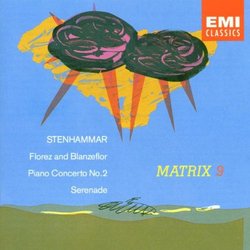| All Artists: Stenhammar, Solyom, Westerberg, Mpo Title: Florez Och Banzeflor / Piano Concerto 2 Members Wishing: 0 Total Copies: 0 Label: Capitol Release Date: 3/15/1994 Genres: Pop, Classical Styles: Vocal Pop, Opera & Classical Vocal, Forms & Genres, Concertos, Serenades & Divertimentos, Instruments, Keyboard Number of Discs: 1 SwapaCD Credits: 1 UPC: 724356508125 |
Search - Stenhammar, Solyom, Westerberg :: Florez Och Banzeflor / Piano Concerto 2
 | Stenhammar, Solyom, Westerberg Florez Och Banzeflor / Piano Concerto 2 Genres: Pop, Classical |
Larger Image |
CD DetailsSimilar CDs
|
CD ReviewsA mixed bag, evocative of Sibelius at its best, otherwise fu Discophage | France | 09/04/2007 (3 out of 5 stars) "EMI Matrix was an interesting and short-lived collection launched in the mid-1990s. It was devoted to reissues of rare and off-the-beaten track repertoire from the 19th and 20th Century, all taken from the EMI archive, with recordings from the late 1960s and the '70s. Among their poles (pun intended) were the orchestral works of Szymanowski, Lutoslawski and Penderecki, as well as piano music of Dutilleux, Dukas and Florent Schmitt by John Ogdon, recordings by the London Melos Ensemble of chamber works of Janacek and Nielsen and - the last release that I have been able to retrace - of Berwald, Spohr and Weber (see my review of Berwald, Spohr, Weber: Chamber Works). I believe the collection didn't go past two years of existence and thirty releases. Scandinavian music was also one of the collection's focuses, with releases of Sibelius' Kullervo, Herbert Blomstedt's first recording of the Nielsen symphonies (he re-made them for Decca in the late 1980s), the symphonies and concertos of Berwald, choral works of Niels Gade and the present disc - volume 9 of the collection - devoted to Stenhammar. I think Stenhammar's 2nd Symphony, a fascinating mix of Bruckner and Nielsen, is a great work, and I've enjoyed his String Quartets. So my interest in the collection and my previous positive encounters with the composer were two reasons to investigate this disc. I am a bit disappointed, though. The Serenade is Stenhammar's most famous work and one understands why. The fast movements (opening Overture, Scherzo proper, Finale) have a lightness reminiscent of Mendelssohn's and Sibelius' scherzos. The two slow movements (Canzonetta and Notturno) are beautifully lyrical and restrained, the Canzonetta a subtle and refined Waltz and the Notturno evoking the Nordic vistas of Sibelius' slow movements. To be honest, Sibelius comes a lot to mind (and it is the early Sibelius of the first three symphonies rather than the mature composer of the later ones), and this is where Stenhammar, I find, is at his best. On the other hand, I am afraid I can't muster as much appreciation for the Concerto (Stenhammar's second). At its best it shares some of the same features of the Serenade, like its Mendelssohnian Scherzo; it also has a first movement built on a biting rhythmic orchestral cell reminiscent of Nielsen But even these elements are watered down by a meandering, Rachmaninoff-like piano part and many orchestral developments that I find very bombastic and hollow. Oftentimes Stenhammar's inspiration is short, as in the trio section of the Scherzo, which he tries to build from a motif that in the first place seems barely sufficient to nourish the five last bars; well, Beethoven was a master at that, but obviously not Stenhammar, who instead of "building" anything simply obstinately repeats the scanty material. Much the same can be said of the Adagio, in which some strikingly Sibelian turns of phrase here and then catch the ear out of the numbness produced by an aimlessly meandering piano part and an orchestral accompaniment full of tritely grand and bombastic gestures. The finale with its merry and triumphant hunt-like orchestration is conspicuously full of bounce, but I find it again hollow and bombastic, evocative of all those sub-par Romantic concertos with lots of notes and little substance in which such pianists such as Michael Ponti and Raymond Lewenthal in the LP era, Marc-André Hamelin and Stephen Hough nowadays seem to revel (appropriately, a search on the present website on "Stenhammar Piano Concerto" yields, as an aside, an informative Listmania by Dr. P. Schulte devoted to "Classical and Romantic Piano Concertos, ca 1800-1880" - they are all there!). But those who like the said works as well as the Piano Concertos of Rachmaninoff (I don't) will probably enjoy Stenhammar's more than I did. The Ballad "Florez och Blanzeflor" (Flower and Whiteflower) Op. 3 for baritone and orchestra goes from the pastoral to the comically heroic. The music is a catalog of Romantic clichés. Am I happy that it is not an opera that I am forced to hear complete. Good sound from 1970 and 1974. " SWEDE WILHELM DAVID BRYSON | Glossop Derbyshire England | 02/22/2009 (4 out of 5 stars) "The neglect of Stenhammar in the latter half of the 20th century left Sweden, the largest of the Scandinavian countries, with a lower profile in the classical musical world than its smaller neighbours. Norway had Grieg and Svendsen, Denmark boasted Nielsen, but Sweden seemed to have produced no major figure since Berwald a couple of generations earlier. This was ironic, since far and away the biggest figure, Sibelius himself, was from a Swedish family although it was his Finnish identity that he chose to stress.
If I try hard enough, I can half-persuade myself that I detect some Nordic commonality among these composers. There may be a hint of the second symphony of Sibelius in the finale of Stenhammar's serenade, but I don't know which is the earlier work. There may be the occasional suggestion of Nielsen, but Nielsen was such a musical chameleon that resemblances to him can occur by accident. Grieg's music does not remind me of Norway because, like Shaw, I have never been there. Whether Stenhammar's music reminds me of Grieg's I am not sure, but I sense a vague `nordic' idiom that may be the result of a similar musical upbringing. As for a distinctively Swedish tone, Berwald is too far in the past, and probably too Germanised, to provide a useful comparison, and the only other 20th century Swedish music I know is Abba. Around the turn of the 20th century Stenhammar was much more famous, both as a pianist and as a composer. His first piano concerto was premiered under the baton of Richard Strauss himself. It is apparently a work on the scale of the Brahms B flat concerto, but by way of an introduction to Stenhammar I don't regret starting with the second, a smaller work lasting half an hour. It is in 4 movements, including a scherzo of the familiar Mendelssohnian type, and the four movements are played without intervals as in Mendelssohn's concertos. In his liner note Robert Layton points to a certain influence of Saint-Saens, and that, I suspect, gives at least as much clue to the style of Stenhammar as any searching after nordic elements is ever likely to. Saint-Saens was more a less a stateless person in musical terms, and a similarly ecumenical spirit can probably be found in Stenhammar. Mendelssohn is here quite unmistakably, but although I looked for Rachmaninov in the concerto my quest was fruitless. I feel able to recommend this disc first because I think it is a good one, but also because it offers a nice variety of compositions. In the 5-movement serenade and in Florez och Blanzeflor the orchestra is the Swedish Radio Orchestra, in the concerto it is the Munich Philharmonic, all three works conducted by Stig Westerberg. The recording will do perfectly well, although early 70's sound is not third millennium sound in general, and in particular the piano is recorded too close-up in the concerto, a common practice at that time. The soloist is Janos Solyom, and he does very well by and large. The recorded sound gives full value to the depth of his tone if not to the brilliance of his runs and passage work, but I could not get out of my head that I wanted to hear this solo part done by Richter, who would have been the soloist from heaven here. However, among them they have succeeded in enthusing me sufficiently over the piece to go looking by-and-by for another version. The name of Andsnes comes to mind obviously, but if he is not available I don't need to be too nationalistic and I'm sure Hamelin would be good to hear, or Peter Donohoe if he is through with his British piano concertos project. There were also not many things that Ogdon didn't play, and it may be rewarding to delve into his discography too. The serenade and Florez can surely not both be op 3? The serenade is the later work, and was subjected to considerable revision. It is attractive although not exactly remarkable in my own opinion, but such as it is it is winningly presented here. Florez och Blanzeflor definitely is remarkable, but perhaps more for its text than for the music, fine though the music is. For the second time in barely a month, I have acquired a musical setting of a poem dealing with the theme of the death of young lovers in their night of passion, and I am just slightly spooked by the coincidence. The other is Respighi's setting of Il Tramonto, an Italian version of a startling poem of Shelley, and you can hear that vividly rendered by Anne-Sofie von Otter in a recent recording. The soloist here is Ingvar Wixell, and it will be no surprise to experienced music-lovers to be told that he performs magnificently, with a grave and beautiful tone. I recommend the experience of this disc cordially. If I withhold a fifth star it is because the piano solo is just short of that rating, particularly as recorded. The liner note is as urbane as we know to expect from Robert Layton, but I must say that if he had felt like taking the trouble he could have produced something a great deal more significant. Such reservations aside, this set has succeeded in the basic respect that it has aroused my interest in this composer considerably. Some of his string quartets suggest themselves to me as a next stop, and if you choose to join me on this journey, or indeed are ahead of me already, then bon voyage." |



